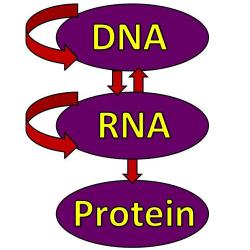Source Institutions
Source Institutions
Add to list Go to activity

In this activity, learners take on the role of various parts of the cell in order to model the process of protein synthesis. Each learner receives a card describing, step by step, what s/he should be doing. Learners play the roles of either RNA codons, an RNA polymerase, messenger RNA, a ribosome, or transfer RNA. This activity is designed for a large group of 30 learners, but could be used with smaller groups of at least 10 learners. [Activity is publicly available through a web crawler capture on Archive.org.]
- 1 to 2 hours
- 45 to 60 minutes
- $1 - $5 per group of students
- Ages 11 - 18
- Activity, Lesson/Lesson Plan, Simulation
- English
Quick Guide
Materials List (per group of students)
- Genetic Code handout
- 1 assembled paper DNA model, 60 base pairs long (1 codon per student acting as a tRNA)
- Factory Instructions (follow the teacher instructions on the top of the page for how many copies of each to make)
- DNA puzzle pieces, each on a different colored paper
- Scissors
- 8 rolls of Scotch tape
- Bins or trays on which to keep the puzzle pieces
Subjects
-
Life Sciences
-
Cells
- Cell Structure and Function
-
Heredity and Genetics
- Human Genetics
- DNA Structure and Function
-
Cells
-
Physical Sciences
-
Chemistry
- Chemistry of Life
-
Chemistry
Informal Categories
- Model Building
Audience
To use this activity, learners need to:
- see
- see color
- read
- hear
- touch
Learning styles supported:
- Involves hands-on or lab activities
Other
Components that are part of this resource:
Includes alignment to state and/or national standards:
Includes assesments for student learning:
This resource is part of:
Access Rights:
- Free access
By:
- Salter, Irene
Rights:
- Creative Commons: Non-commercial (by-nc), Irene Salter,
Funding Source:
- Rose Foundation
